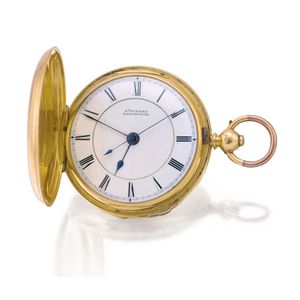1910 A. Lange & Sohne 14ct Gold Pocket Watch
You must be a subscriber, and be logged in to view price and dealer details.
Subscribe Now to view actual auction price for this item
When you subscribe, you have the option of setting the currency in which to display prices to $Au, $US, $NZ or Stg.
- Movement - The technical name for the workings of a clock or watch, and does not include the dial or case.
- Keyless Watch - A keyless watch is a type of pocket watch or wristwatch that does not require a separate winding key to wind or set the time. Instead, a keyless watch is wound and set by a small knob or button located on the side of the watch, called a crown.
Keyless watches were first introduced in the late 19th century and quickly became popular due to their convenience and ease of use. Prior to the development of keyless watches, pocket watches were typically wound and set using a small key that was inserted into a hole in the watch case. The key would be turned to wind the watch's mainspring, and then turned again to set the time.
With the introduction of the keyless watch, watchmakers were able to simplify the winding and setting process by eliminating the need for a separate key. Instead, the crown on the side of the watch could be pulled out to set the time, and then pushed back in to wind the watch's mainspring.
The keyless watch design has since become the standard for most modern watches, both pocket and wristwatches. In addition to being more convenient to use, keyless watches are also typically more reliable and accurate than earlier models that used winding keys. - Circa - A Latin term meaning 'about', often used in the antique trade to give an approximate date for the piece, usually considered to be five years on either side of the circa year. Thus, circa 1900 means the piece was made about 1900, probably between 1895 and 1905. The expression is sometimes abbreviated to c.1900.
- Subsidiary Dial - On a clock or watch, a subsidiary dial, also called an auxiliary dial, is a dial that is secondary to the main dial and may show seconds, day of the week or month, or strike silent. A subsidiary dial may be within our outside the main dial, and a clock or watch may have several subsidiary dials.
This item has been included into following indexes:
- pocket watches, case type
Visually similar items

William Picken Edinburgh an 18ct gold hunting cased pulse watch no 4182 circa 1890, fusee lever movement signed William Picken, Edinburgh key wind, key set, gold cuvette, white enamel dial with 30 pulse beat scale enclosing Roman numerals, pulsemeter activ

A Swiss gold plated Hour Repeat pocket watch, c.1910, hunter case with lever movement. Enamel dial in good condition. Diameter 57 mm.

Vacheron & Constantin An 18ct gold hunting cased watch mvt 397592 case 249660 circa 1920, lever movement, fully jewelled, white enamel dial, Arabic numerals, outer minute track, subsidiary seconds dial, gold spade baton hands, gold cuvette, plain polished

A Rolex 9ct gold full hunter pocket watch, white enamel dial signed Rolex, with black Roman numerals, blued hands, subsidiary seconds on a Rolex lever movement, in a guilloche case by American watch case Company of Toronto Canada, (glass dislodged), size 5
